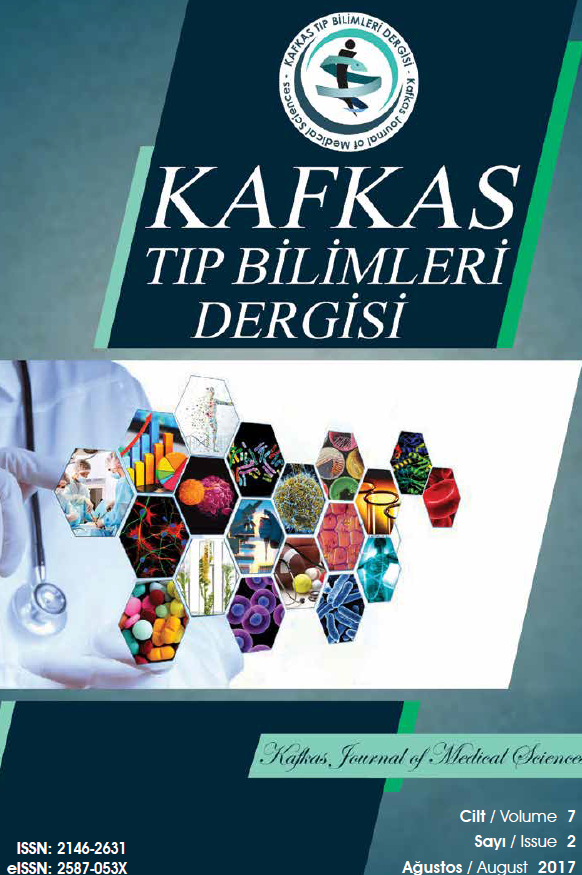Pasif Sigara İçici Bebeklerde Serum Antioksidan Vitamin Düzeyleri ve Beslenme Tipiyle İlişkisi
anne sütü, vitamin A, vitamin C, vitamin E, pasif sigara içiciliği.
The Relationship Between Serum Antioxidant Vitamin Levels and Type of Nutrition in Passive Smoker Infants
___
- 1. Erguder, T. Tobacco use and prevention programs (Tütün Kullanımı ve Önleme Programları). Halk Sağlığı İle İlgili Güncel Sorunlar ve Yaklaşımlar, 2009;22-25.
- 2. Örsel O. Tütün içeriği, farmako-kinetiği ve tütün ürünleri. Ed (Karadağ M, Bilgiç H) Tütün Kontrolü. İstanbul Türk Toraks Derneği, 2010;131-40
- 3. Bartal M. Health effects of tobacco use and exposure. Monaldi Arch Chest Dis 2001;56(6):545-54
- 4. Ayçicek A, Koçyiğit A. İncreased oxidative stres in infants exposed to passive smoking. Eur J. Pediatr 2005;164:777-8
- 5. Kaleli S. Sigaranın sağlık üzerine zararlı etkileri. Fırat Sağlık Hizmetleri Dergisi 2010;5(14):39-56
- 6. Lim R, Sobey CG. Maternal nicotine exposure and fetal programming of vasculer oxidative stress in adult offspring. British Journal of Pharmacology 2011;164:1397-99
- 7. Bolisetty S, Naidoo D, Lui K, Koh TH, Watson D, Montgomery R et all. Postnatal changes in maternal and neonatal plasma antioxidant vitamins and the influence of smoking. Arch Dis Child Fetal Neonatal Ed 2002;86:36-40
- 8. Yilmaz G, Isık Agras P, Hızlı S, Karacan C, Besler HT, Yurdakok K et al. The effect of passive smoking and breast-feding on serum antioxidant vitamin (A, C, E) levels in infants. Acta Paediatr. 2009;98(3):531-6
- 9. Jendryczko A, Szpyrka G, Gruszczynski J, Kozowicz M. Cigarette smoke exposure of school children: effect of passive smoking and vitamin e supplementation on blood antioxidant status. Neoplasma 1993;40:199-203
- 10. Harlap S, Davies AM. İnfant admissions to the hospital and maternal smoking. Lancet 1974;1:529-32
- 11. Becker AB, Manfreda J, Ferguson AC, Dimich-ward H, Watson WT, Chanyeung M. Breast-feeding and environmental tobacco smoke exposure. Arch Pediatr Adolesc Med. 1999;153:689-691
- 12. Luck W, Nau H. Exposure of the fetus, neonate, and nursed infant to nicotine and cotinine from maternal smoking. New Eng J Med. 1984;311:672
- 13. Dahlström A, Lundell B, Curvall M, Thapper L. Nicotine and cotinine concentrations in the nursing mother and her infant. Acta Paediatr Scand. 1990;79(2):142-7.
- 14. Batstra L, Neeleman J, Hadders-Algra M. Can breast feeding modify the adverse effects of smoking during pregnancy on the child's cognitive development?. Journal of Epidemiology & Community Health. 2003;57(6):403-4.
- 15. Mennella JA, Yourshaw LM, Morgan LK. Breastfeeing and smoking short-term effects on infant feeding and sleep. American Acedemy of Pediatrics 2007;120(3):497-502
- 16. Bruno RS, Ramakrishnan R, Montine TJ, Bray TM, Traber MG. Alpha-Tocopherol disappearance is faster in cigarette smokers and is inversely related to their ascorbic acid status. Am J Clin Nutr 2005;81:95-103.
- 17. Tribble DL, Giuliano LJ, Fortmann SP. Reduced plasma ascorbic acid concentrations in non-smokers regularly exposed to environmental tobacco smoke. Am J Clin Nutr 1993;58:88-90
- 18. Preston AM, Rodriguez C, Rivera CE, Sahai H. Influence of environmental tobacco smoke on vitamin C status in children. Am J Clin Nutr 2003;77:167-72.
- 19. Strauss RS. Environmental tobacco smoke and serum vitamin C levels in children. Pediatrics 2001;107:540-42.
- 20. Alberg AJ, Chen JC, Zhao H, Hoffman SC, Comstock GW, Helzlsouer KJ. Household exposure to passive cigarette smoking and serum micronutrient concentrations. Am J Clin Nutr 2000;72:1576-82.
- 21. Ortega RM, López-Sobaler AM, Quintas ME, Martínez RM, Andrés P. The influence of smoking on vitamin c status during the third trimester of pregnancy and vitamin c levels in maternal milk. Journal of The American Callege of Nutrıtıon 1998;17(4):379-84
- 22. Ortega RM, López-Sobaler AM, Martínez RM, Andrés P, Quintas ME. Influence of smoking on vitamin E status during the third trimester of pregnancy and on breast-milk tocopherol concentrations in spanish women. Am J Clin Nutr 1998;68:662-67.
- 23. Boersma ER, Offringa PJ, Muskiet FA, Chase WM, Simmons IJ. Vitamin E, lipid fractions, and fatty acid composition of colostrum, transitional milk, and mature milk: an international comparative study. Am J Clin Nutr 1991;53(5):1197-204.
- ISSN: 2146-2631
- Yayın Aralığı: Yılda 3 Sayı
- Başlangıç: 2011
- Yayıncı: Kafkas Üniversitesi
Prenatal Dönemdeki Gebe Kadınların Gebeliğe ve Anneliğe Uyumu ile İlişkili Faktörler
Pınar Döner GÜNER, Hande BÖLÜKBAŞI, Elif TEZCAN, İlay GÖZÜKARA, Ali Ulvi HAKVERDİ, Cahit ÖZER
Kadınların Genital Hijyene İlişkin Davranışlarının Belirlenmesi
Aynı Kitle İçerisinde Dermatofibrosarkom Protuberans Ve Miksofibrosarkom, Çok Nadir Olgu Sunumu
Elif Gökçe DEVECİOĞLU, Nazlı Sena ŞEKER
Gebe Okulları Doğum Korkusunu Azaltmada Etkili Bir Uygulama Mıdır?
Abdullah TOK, Hilal SAKALLIOĞLU
Gülnihal DENİZ, Ahmet KAVAKLİ, Özen KAN ŞİKOĞLU, Ahmet Zafer PERİLİOĞLU, Yıldız ECE, Murat ÖGETÜRK, Furkan BİLEK
Karaciğer Fibrozisinde Sitokinlerin Rolü
Nefroloji Polikliniği’nde Hiperpotasemi Saptanan Hastaların Klinik ve Laboratuvar Özellikleri
